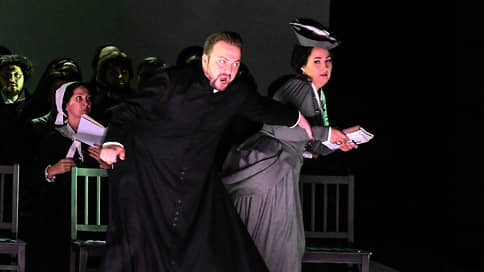Attraction of unheard-of Verdiianness – Newspaper Kommersant No. 177 (7378) of 09/24/2022
[ad_1]

The Moscow Novaya Opera opened the season with a new production of Stiffelio, an almost unknown masterpiece by Giuseppe Verdi, an opera never performed on Russian stages. How is this possible and what came of it – explains Ekaterina Biryukova.
Of the 26 Verdi operas, Stiffelio for a long time had the role of a loser of a difficult fate. Things did not work out even at birth in 1850. Three days before the premiere, the theater in Trieste demanded from the composer and his librettist Francesca Maria Piave, for censorship reasons (this was the era of reaction after the revolutionary unrest of 1848-1849), to urgently make a number of significant changes to the text. It was based on the modern provocative French play “The Priest, or the Gospel and the Heart”, which obviously offends Italian Catholics with the story of a married evangelical pastor who forgives his traitor wife and, oh horror, conducts worship right on the opera stage. As a result, the title character shrank to the head of some fictional Protestant sect. In the future, the opera was repeatedly remade, shredded and completed, changed its name, time and place of action, but this still did not bring her happiness.
The original score of Stiffelio was considered lost. Only in the 1960s was a copy of the score discovered, and in 1992 – the author’s material. The fact that Verdi has one more masterpiece than we used to think was solemnly announced in 1993 by the production of the Metropolitan Opera with James Levine at the console and Plácido Domingo in the title role. The rest of the operatic world also began to show interest in Verdi’s novelty. It’s no joke – everyone around complains about the lack of new titles, and here is such a gift with luxurious tenor, soprano and baritone parts, virtuoso ensembles and choirs, a rich orchestra, spectacular explosive dynamics and melodies tightly stuck in my head! In some of them, the future is guessed, unknown to the composer himself, but Violetta, Gilda, Rigoletto, even Othello, well known to us. But sometimes it is worth recognizing that we have never heard such Verdi at all.
The opera was first performed in Russia in 2020 — maestro Alexander Samoile, who has long been in love with this score, conducted a concert performance as part of the New Opera Epiphany Festival. And finally, a full-fledged production arrived. Its authors are director Ekaterina Odegova and set designer Etel Ioshpa. Lighting designer Stas Svistunovich must be added to this well-coordinated duet, which has already released several charming productions at the Novaya Opera. The cinematic play of shadows and light spots in the most laconic black-and-white space of the new performance is no less important than the acting. The trademark nonchalant swirling of Verdi’s music is also delicately shaded. And maestro Samoile enthusiastically shows its complexity, ambiguity and multilayeredness.
On the stage – an emphatically restrained and sedate society, tightened in corsets of the Victorian era. Here they gracefully play an old theater with its eternal secret notes falling out from somewhere. Here, Rafael von Leutold, the unfortunate lover of the protagonist Lina, holds on to the amusing hero of an operetta or silent film. And her father, Count Stankar, during his aria – the only concert hit of this opera – unexpectedly makes the audience laugh in the most farcical way. He is obsessed with a thirst for revenge and, grotesquely choosing a weapon to kill the seducer, first sharpens the ax, then gets stuck with his foot in his own trap and, to the general laughter, briefly falls into the grave dug on the stage during the intermission. The star of the theater baritone Andrzej Bielecki is unrivaled in this role.
However, the experiences of the penitent Lina and her husband Stiffelio, tormented by jealousy, spill out onto the viewer with a shocking reality, this is no longer a stylized theatrical convention. It is clear that a lot depends on whether the theater has managed to find a suitable tenor (which, as you know, is a scarce commodity). In the performance of the Novaya Opera, this part of the Otellian scale is quite worthy, although Sergey Polyakov, a guest artist of the theater, drags along with him not without loss. There were two performers of the main and also very responsible female soprano part in the troupe. The soaring voice of Marina Nerabeeva from the first cast ideally reigns in her belkant cloud, the voice of Elizaveta Soina, who sang the second performance, is more earthy and harsh.
So, the priest Stiffelio cannot control his rage and aggression, cannot come to an agreement with God. The grave in the second act turns black for a reason. The black and white coloring of the performance is, of course, eventually diluted with bloody red. According to the Verdi plot, there is only one corpse in the opera: Stankar killed Raphael. But the final scene of the performance, addictive with its gloomy and strange beauty, seems to transfer all the other characters to some other dimension. While Stiffelio reads to them the canonical text from the Gospel of John “who is without sin, let him be the first to throw a stone”, Lina, whom he had just, contrary to Verdi’s instructions, not forgiven, but beaten to death, is sitting dead like a kind of Salome with a severed head your lover in your arms. The jubilation of the choir against this background sounds rather frightening. Strauss’ Salome, by the way, is one of the previous productions of the girl duet Odegova-Ioshpa. Together with their own Britten’s Lamentation of Lucretia, a triad of “women’s” operas is already taking shape, quietly, but intelligently and persistently asking sharp, painful questions.
[ad_2]
Source link






